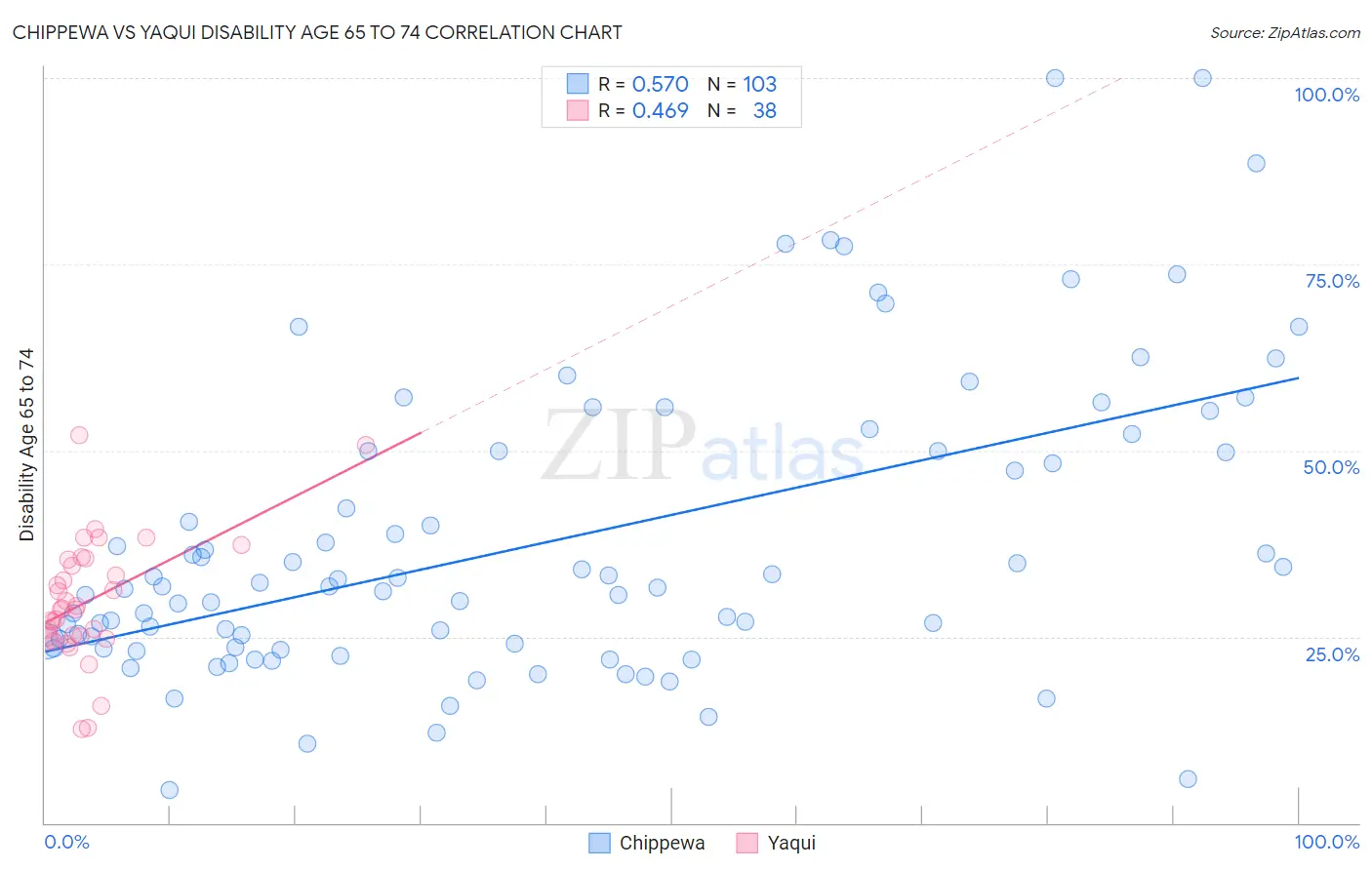Chippewa vs Yaqui Disability Age 65 to 74
COMPARE
Chippewa
Yaqui
Disability Age 65 to 74
Disability Age 65 to 74 Comparison
Chippewa
Yaqui
27.8%
DISABILITY AGE 65 TO 74
0.0/ 100
METRIC RATING
314th/ 347
METRIC RANK
27.4%
DISABILITY AGE 65 TO 74
0.0/ 100
METRIC RATING
309th/ 347
METRIC RANK
Chippewa vs Yaqui Disability Age 65 to 74 Correlation Chart
The statistical analysis conducted on geographies consisting of 214,741,150 people shows a substantial positive correlation between the proportion of Chippewa and percentage of population with a disability between the ages 65 and 75 in the United States with a correlation coefficient (R) of 0.570 and weighted average of 27.8%. Similarly, the statistical analysis conducted on geographies consisting of 107,674,175 people shows a moderate positive correlation between the proportion of Yaqui and percentage of population with a disability between the ages 65 and 75 in the United States with a correlation coefficient (R) of 0.469 and weighted average of 27.4%, a difference of 1.6%.

Disability Age 65 to 74 Correlation Summary
| Measurement | Chippewa | Yaqui |
| Minimum | 4.3% | 12.5% |
| Maximum | 100.0% | 52.0% |
| Range | 95.7% | 39.5% |
| Mean | 37.7% | 29.8% |
| Median | 31.7% | 28.7% |
| Interquartile 25% (IQ1) | 23.6% | 25.0% |
| Interquartile 75% (IQ3) | 50.0% | 35.4% |
| Interquartile Range (IQR) | 26.4% | 10.4% |
| Standard Deviation (Sample) | 19.8% | 8.4% |
| Standard Deviation (Population) | 19.8% | 8.2% |
Demographics Similar to Chippewa and Yaqui by Disability Age 65 to 74
In terms of disability age 65 to 74, the demographic groups most similar to Chippewa are Paiute (27.8%, a difference of 0.010%), Cajun (27.9%, a difference of 0.47%), Crow (27.9%, a difference of 0.52%), Immigrants from Armenia (28.0%, a difference of 0.60%), and Nepalese (28.0%, a difference of 0.83%). Similarly, the demographic groups most similar to Yaqui are Shoshone (27.4%, a difference of 0.050%), Sioux (27.3%, a difference of 0.060%), Ute (27.3%, a difference of 0.21%), Black/African American (27.3%, a difference of 0.27%), and Menominee (27.4%, a difference of 0.27%).
| Demographics | Rating | Rank | Disability Age 65 to 74 |
| Immigrants | Mexico | 0.0 /100 | #301 | Tragic 27.1% |
| Central American Indians | 0.0 /100 | #302 | Tragic 27.1% |
| Tlingit-Haida | 0.0 /100 | #303 | Tragic 27.1% |
| Puget Sound Salish | 0.0 /100 | #304 | Tragic 27.2% |
| Mexicans | 0.0 /100 | #305 | Tragic 27.2% |
| Blacks/African Americans | 0.0 /100 | #306 | Tragic 27.3% |
| Ute | 0.0 /100 | #307 | Tragic 27.3% |
| Sioux | 0.0 /100 | #308 | Tragic 27.3% |
| Yaqui | 0.0 /100 | #309 | Tragic 27.4% |
| Shoshone | 0.0 /100 | #310 | Tragic 27.4% |
| Menominee | 0.0 /100 | #311 | Tragic 27.4% |
| Osage | 0.0 /100 | #312 | Tragic 27.5% |
| Paiute | 0.0 /100 | #313 | Tragic 27.8% |
| Chippewa | 0.0 /100 | #314 | Tragic 27.8% |
| Cajuns | 0.0 /100 | #315 | Tragic 27.9% |
| Crow | 0.0 /100 | #316 | Tragic 27.9% |
| Immigrants | Armenia | 0.0 /100 | #317 | Tragic 28.0% |
| Nepalese | 0.0 /100 | #318 | Tragic 28.0% |
| Arapaho | 0.0 /100 | #319 | Tragic 28.1% |
| Cherokee | 0.0 /100 | #320 | Tragic 28.2% |
| Comanche | 0.0 /100 | #321 | Tragic 28.3% |